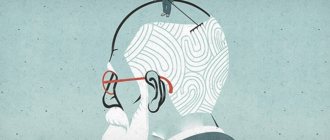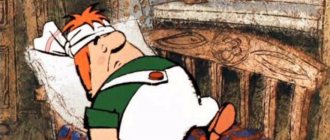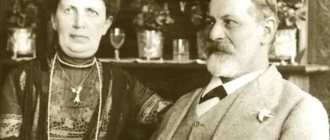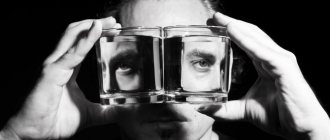Nowadays all kinds of aphorisms about the meaning of life are in fashion. Here are some of the most popular:
“The more perfect a person is on the outside, the more demons he has inside.” “The only person you should compare yourself to is your past self. And the only person you should be better than is you now.” “A person never gives up anything, he simply replaces one pleasure with another.”
But, putting these beautiful phrases in statuses, publishing them on social networks, quoting them in companies, most people do not even realize that they belong to the famous psychologist of the first half of the 20th century, Sigmund Freud, and reflect the whole essence of his teaching, known as psychoanalysis.
What is psychoanalysis
Psychoanalysis is a theory founded by Sigmund Freud, as well as a method for eliminating psychological problems.
When developing the theory, the famous Austrian psychotherapist used many years of experience gained during his medical practice.
So, what do the basic principles of psychoanalysis say?:
- Conflicts between the conscious and unconscious can lead to neuroses, fears, depression and other mental disorders.
- A person’s experience, knowledge and behavior are formed on the basis of his irrational unconscious drives.
- An individual trying to realize these drives “turns on” defense mechanisms that interfere with the process of awareness.
- The influence of the unconscious can be neutralized through its awareness. Psychoanalysis is a therapy that involves solving a problem.
The key idea of psychoanalysis comes down to the statement that a person is not aware of his own motives for behavior - they need interpretation. According to Freud's classical psychoanalysis, the patient should voice all his thoughts, associations, and dreams. The task of a psychoanalyst is to analyze what he hears.
Alternatives
Alternatives to psychoanalysis include cognitive behavioral psychotherapy, art therapy, Jungian analytical psychotherapy, behaviorism, Gestalt therapy, logotherapy, positive psychotherapy, psychodrama, body-oriented psychotherapy, Ericksonian hypnosis. All this, like psychoanalysis, methods of psychotherapy. They cannot fully replace each other, because these are completely different directions, but they have the same goal - to help a person realize the internal problem and get rid of it.
History of psychoanalysis
The history of psychoanalysis dates back to 1880, in the days when the Viennese physician J. Breuer shared with his comrade S. Freud a remarkable story about a patient who was cured of the symptoms of hysteria after a hypnosis session. At the reception, she was able to voice a deeply traumatic event that happened to her. The result was a strong emotional reaction. Catharsis resulted in a significant reduction in symptoms. When the patient emerged from the hypnosis state, she had no memory of her confessions.
Freud decided to apply the technique with his patients - Breuer's results were confirmed. The partners shared their findings in a joint publication, Research on Hysteria, arguing that the symptoms of hysteria are caused by repressed memories of traumatic events. The difficult situation is repressed from consciousness, but continues to influence the patient.
Personal reasons prompted Breuer to withdraw from research and Freud began independent work. He was able to discover that a similar result is achieved not only with hysteria, but also with obsessive states of a sexual nature, often arising in childhood.
The psychoanalyst initially considered the Oedipus complex to be the key cause of neuroses. The symptom begins to form at moments when the child’s unconscious drives threaten to break through the barrier set by repression, which turns out to be unacceptable for other parts of the psyche due to fear of punishment and for moral reasons.
Basics of psychoanalysis
Psychoanalysis is a therapy based on several immutable principles:
- First of all, the principle of determinism is implied. According to the ideas of psychoanalysis, not a single manifestation of the psyche can be called random, unrelated to anything, or involuntary. Conscious feelings, thoughts, impulses should be considered as events of cause-and-effect interactions determined by early childhood experience. Special research methods (mainly through dream analysis and associations) reveal the connection between situations from the past and current psychological experience.
- The basis of the second principle was the topographical approach. All mental elements are assessed according to the criteria of their accessibility. Repression, which ensures the removal of certain psychological elements from consciousness, indicates that a certain part of the psyche is making efforts without wanting to realize them.
- The third dynamic principle is based on the theory that the psyche is driven to action by impulses of aggression and sexuality, which are elements of a common biological heritage. They have significant differences from the instinctive behavior of animals. In the animal world, a stereotypical response is usually recorded, provoked by special stimuli in certain situations and aimed at survival. Psychoanalysis considers attraction as a state of nervous excitement, which is a response to stimuli that direct the psyche to action and relieve tension.
- The fourth principle is the genetic approach. The personality traits of an adult, characterizing his conflicts and neurotic symptoms, are generally associated with the fantasies and desires of childhood. It is believed that no matter what paths open to a person, he will not be able to escape from his own childhood experiences - in any case, they will haunt him throughout his life.
Methods of psychoanalysis
Let us consider in detail the main methods used in the field of psychoanalysis: the method of dream interpretation, the method of free association, the method of interpretation. Let's describe each one separately.
Free association method
What is this famous method based on? On the use of the phenomenon of associative thinking in order to study deep mental phenomena and processes (often they are unconscious). The data obtained are used for the treatment and correction of functional mental disorders, with the help of the patient’s awareness of the nature and source of the problems.
What is special about the free association method? In a conscious joint and purposeful confrontation between the therapist and the patient with a state of psychological discomfort. Acting together, the psychoanalyst and the patient cope with the problem.
The method of free association can be called a method for studying the mental state of a patient. He talks about any thoughts that come into his head, no matter how absurd or inappropriate they may seem. They may sound fantastic, ordinary, obscene. The therapist has to draw a conclusion from these revelations or incoherent fragments of thoughts.
In the “Dictionary of Psychoanalysis” (J.B. Pontalis, J. Laplanche) it is noted that free associations can be called the expression of all indiscriminately ideas and thoughts that arise in the mind - spontaneously or starting from any element (number, word, image from a dream).
Freud called for abandoning the role of controlled consciousness, beginning to understand mental processes. He stated that consciousness tries to eliminate images and thoughts that appear on the periphery before the attention of the analyzing object is focused on them. Moreover, when analyzing the mental state, it is these images and thoughts that can carry special meaning.
It was Freud who first began to actively use the method of free association. The psychoanalyst suggested that his patients lie down on the couch and relax, simply saying whatever came to their mind, no matter how incredible, absurd and unusual these thoughts were from the point of view of usual moral standards. During the sessions, the therapist observed how powerful emotional drives led uncontrolled thinking to mental conflict. The famous psychotherapist stated that the first random image and thought implies exactly what is needed for psychoanalysis. A random thought may have a connection to a repressed memory.
Dream interpretation method
According to the theories of Sigmund Freud, dreams can reveal the presence of intense mental activity in the depths of consciousness. What is dream analysis? The therapist must find the distorted unconscious truth hidden in every dream. Freud was convinced: the stranger and more confusing the dream, the more hidden content it contains. In the language of psychoanalysis, this phenomenon is called resistance - its manifestations can be noticed even when the person who saw the dream does not agree to its interpretation. This speaks of his unconscious resistance, established barriers to protect his own psyche.
Dreams separate the unconscious from the real world. In them, exciting situations that cause emotions are deformed in the most bizarre way. Dreams can also tell about secret desires. In the case of child psychoanalysis, the differences between hidden and overt thoughts are less clear.
Hidden thoughts are transformed into symbols, appearing in a form acceptable to consciousness. This allows them to bypass certain "censorship". Even today, the manifestation of the unconscious in the form of dreams remains one of the greatest mysteries of consciousness.
The method of dream interpretation is very important - it allows you to identify the essence of the images that appear in a dream. Freud processed dreams by positioning them as symptoms of illness. According to him, for the correct use of this method, it is not recommended to consider dreams as something single - such an analysis will not lead to anything worthwhile. He was convinced: when analyzing dreams, it is necessary to painstakingly study its elements separately. The association rule should be applied to individual fragments. Freud considered any dream not only an object worthy of scientific research, but also a way to know one’s deep essence, to discover hidden desires that do not appear on the surface.
Interpretation method
Interpretation is considered one of the most important tools of any analyst. Even in the interpretation of dreams and free associations, interpretations are used by the therapist. What does this term mean?
Interpretation is called the main analytical tool. In dream interpretation and free association, the psychoanalyst attempts to use interpretations. We are talking about transferring significant information about the patient from the unconscious level to the conscious level. Repressing information that causes concern and anxiety in an individual, as well as its correct analysis, will soften the symptoms of neurosis or other mental problems.
PSYCHOANALYTIC THERAPY
Psychoanalytic therapy is both a research method and a treatment method. It is carried out under certain standard conditions, called the “psychoanalytic situation”. The patient is asked to lie down on the couch, face away from the therapist, and tell the therapist in detail and honestly about all the thoughts, images, and feelings that come to mind. The psychoanalyst listens to the patient without criticizing or expressing his own judgments. According to the principle of mental determinism, each element of thinking or behavior is observed and evaluated in the context of what is being told. The personality of the psychoanalyst himself, his values and judgments are completely excluded from the therapeutic interaction. This organization of the psychoanalytic situation creates conditions under which the patient’s thoughts and images can emerge from very deep layers of the psyche. They arise as a result of the constant internal dynamic pressure of drives that give rise to unconscious fantasies (dreams, free associations, etc.). As a result, what was previously repressed is verbalized and can be studied. Since the psychoanalytic situation is not complicated by the influence of ordinary interpersonal relationships, the interaction of the three components of the psyche - Ego, Id and Super-Ego - is studied more objectively; this makes it possible to show the patient what exactly in his behavior is determined by unconscious desires, conflicts and fantasies, and what by more mature ways of responding.
The goal of psychoanalytic therapy is to replace stereotypical, automated ways of responding to anxiety and fears with objective, reasonable judgment. The most important part of therapy is related to the interpretation of the patient's reactions to the psychotherapist himself. During treatment, the patient's perception of the psychoanalyst and the demands placed on him often becomes inadequate and unrealistic. This phenomenon is known as “transfer” or “transfer”. It represents the patient's unconscious recovery of a new version of forgotten childhood memories and repressed unconscious fantasies. The patient transfers his unconscious childhood desires to the psychoanalyst. Transference is understood as a form of memory in which repetition in action replaces the recollection of the past and in which the reality of the present is misinterpreted in terms of a forgotten past. In this regard, transference is a repetition in miniature of the neurotic process.
Psychoanalysis in psychology and philosophy
One can hear many general statements about psychoanalysis. It is usually noted that psychoanalysis is a well-known direction in psychology, the benefits and significance of which are assessed differently. The method has both supporters and opponents.
If we talk about psychoanalysis in a philosophical vein, it is noted that a feature of psychoanalytic concepts is their connection with psychotherapeutic practice. It is not reduced to either experimental knowledge or philosophical speculation, but grows from the experience of communication and other aspects. Real comprehension of your inner world is achieved through insight. Such insight brings changes to the patient’s life - he begins to think about himself and his beliefs in a completely different way.
This philosophy is somewhat similar to ancient teachings that combined the theory and practice of Zen Buddhism, yoga and other types of mental self-regulation.
The practice of psychoanalysis is periodically compared with the healing actions of priests and shamans. Training in psychoanalysis is equated to initiation. It is no coincidence that many famous analysts who practice psychoanalysis simultaneously show interest in various Eastern teachings and even magic.
Most adherents of Freud's theories, as before, adhere to the model of the human psyche that was supported by the “father of psychoanalysis.” Their beliefs are based on the fact that psychoanalysts usually receive psychological or medical training. Their task is to adapt the patient to surrounding circumstances. To a large extent, psychoanalysis is widespread in America and the most developed European countries.
At one time, Sigmund Freud still hoped that his theories of psychoanalysis would be recognized by the scientific community. For this purpose, he resorted to analogies with archeology, hydraulics, economics and other sciences. Gradually, the conviction began to grow stronger in him that this would not happen after all.
The first reason can be called the difference in approaches, and the second is that for scientists, whose formation took place in the scientific fields of the nineteenth century, psychoanalysis is an unacceptable aspect for personal reasons. The ideas of therapy ran counter to narcissistic illusions about the power of the mind over nature and oneself. In general, the frequency with which many representatives of science and philosophy condemned the principles of psychoanalysis indicates their obvious bias. Gradually these beliefs began to change.
Today, the scientific status of psychoanalysis periodically continues to be challenged. Some researchers are inclined to think that it is still scientific, others question this statement, calling the well-known therapy pseudoscience.
However, in the twentieth century, psychoanalysis became widespread in the humanities, psychology, philosophy and other fields.
Research
Hundreds of scientific studies have been aimed at assessing the effectiveness of mental analysis in neuroses with personality disorders. Psychoanalysis is effective in situations involving a violation of personal relationships with intimacy. As a therapeutic method, psychoanalytic technique is useful in a one-time consultation. Psychoanalysis has been used as a tool to study child development. It has become a method of treating mental disorders.
You may also be interested in: 4K TVs - what is it?
Meta-studies have also been conducted with psychoanalysis. They showed that its effectiveness is comparable to or superior to other types of psychotherapy and treatment with antidepressant drugs. One review article concluded that psychotherapy is more effective than no therapy, standard treatment, or psychodynamic therapy. Research by Caron and his colleagues from Michigan showed that through the proper use of psychodynamic therapy, patients with schizophrenia can be successfully treated.
Interestingly, according to scientific criteria, psychoanalysis is not a pseudoscience, since it is based on independent evidence, denotative validity. Many researchers have proven the effectiveness of psychic analysis, a theory put forward by Sigmund Freud, as well as a number of confirmed studies in practice.
Freud's theory of psychoanalysis: briefly
According to Freud's theory, the human psyche can be “divided” into the following components: Ego, Id and Superego.
Definition of terms:
- The id is the main source of drive and desire. As an analogy, we can cite an ordinary street dog, where all its actions, such as mating, sleeping, etc., are the result of instincts inherent in nature.
- The ego is a mediator that divides social frameworks and animal instincts. The part of the personality that satisfies the needs of the id, taking into account the limitations of the external world.
- The superego implies all social frameworks, starting with the period of parental education, when the foundations are laid for what can be done and what is unacceptable. In adult life, it is reflected in all aspects of life, such as morality, religion, law.
The topical model of the mental apparatus includes two elements: the unconscious and the conscious.
What do they mean:
- The unconscious is psychic forces that are below the level of consciousness. They determine how a person behaves.
- Conscious is a mental aspect that an individual is able to become aware of. Consciousness has a direct impact on how an individual positions himself in society. The psyche can automatically be corrected by the pleasure principle. If the balance is disturbed, then a reset occurs through the unconscious sphere.
Defense mechanisms realize the conflict between the Superego and the Id. Freud described many of them: isolation, projection, repression, denial, substitution, regression and so on.
Ways to resolve internal conflicts
Sigmund Freud offers a solution to intrapersonal conflicts using sublimation, dreaming, compensation and blocking by defense mechanisms. Sublimation is considered to be the redirection of sexual energy to tasks that are approved by society: creativity, the sphere of the intellectual sphere, the social environment. Freud said that dreams serve as unfulfilled human desires. A number of recurring dreams indicate an unfulfilled need that interferes with human psychological development and self-expression. An example of physiological compensation is the perfect hearing that develops in a blind person. Sigmund Freud believed that the human psyche is structured in a special way. The lack of talent is compensated through frantic efficiency.
Defense mechanisms are activated due to emotional stress. They suppress and reject the situation that provokes the conflict. Sigmund Freud lists the phenomenon among them:
- projection (shifting responsibility onto another person);
- substitution (aggressive redirection to a suitable object);
- regression (return to an earlier pattern of behavior);
- denial (ignoring);
- suppression (blocking consciousness, repressing thoughts of anxiety).
This includes rationalization (creating a legend) with reactive formation (factor substitution that provoked emotional overstrain).
Classic psychoanalysis by Sigmund Freud
Having begun to develop a new approach to the treatment of mental problems, Freud initiated his own research and studied the data of other scientists. Nowadays the theory of psychoanalysis is considered truly unique. What distinguishes her from others is that she does not undertake to study individual problems of an individual. Psychoanalysis looks at everything in its entirety. We suggest that you briefly familiarize yourself with the main provisions of therapy.
Classical psychoanalysis is based on the determinism of the biological component - on the assertion that physiological needs suppress all others and indicate their vector. Mental determinism indicates that any incident in a person’s life has its consequences. Each of his actions is determined by an obvious or hidden motive, which was preceded by certain events.
Several aspects of an individual’s mental life are distinguished: conscious, preconscious, unconscious. In the first case, we are talking about experiences and current thoughts, in the second – about secret desires and fantasies, in the third – about what stands out from consciousness, suppressed by the internal censor. Freud believed that psychology should be interested in this complex mechanism in detail.
Psychoanalysis of modern times
Sigmund Freud was convinced that all our actions are dictated by subconscious desires. Particular emphasis was placed on the fact that emerging needs are based on physiology and sexual desires. Modern psychology no longer focuses on this and does not pay too much attention to the statement.
How widespread is psychoanalysis today? In many countries it is quite developed, being quite an ordinary phenomenon. Many modern therapists write books on this topic, which are very popular - that is, it is in demand. Of course, a certain type of society has long resisted the principles of psychoanalysis, not accepting them. This can be said about Germany during the period of National Socialism and the USSR before the Brezhnev stagnation. These examples are the most obvious. Both the fascist and communist regimes opposed Freud's teachings on ideological grounds. The Germans considered these theories “Jewish science that degrades human dignity,” and the Soviet Union considered these theories “the apotheosis of bourgeois individualism.”
Both hidden attempts to oust the teaching from the life of society and obvious repressions against it are known. It is worth recognizing that psychoanalysis also runs counter to many religion-centered and theocratic societies. Although there are cases when it was successfully developed in countries with authoritarian political regimes. The most obvious example is Argentina. According to the assumption of the Argentine psychotherapist A. Benjamin, the reason is that it was the psychologist’s office that usually became the last refuge for oppressed citizens, where freedom of speech was not prohibited.
To summarize, the conclusion suggests itself that freedom is considered the main condition for the successful development of psychoanalysis in society. Let us clarify that in this case, society should share the value of freedom, it should demonstrate the real implementation of freedoms (personality, speech, thought). By the way, for the full development of psychoanalysis, freedom of association is required, which makes it possible for the corresponding community to take shape.
In general, psychoanalysis is quite common in modern society. Various trainings are conducted, therapeutic rooms operate, and relevant literature is published.










